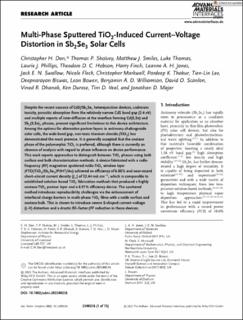| dc.contributor.author | Don, Christopher | |
| dc.contributor.author | Shalvey, Thomas | |
| dc.contributor.author | Smiles, Matthew | |
| dc.contributor.author | Thomas, Luke | |
| dc.contributor.author | Phillips, Laurie | |
| dc.contributor.author | Hobson, Theodore | |
| dc.contributor.author | Finch, Harry | |
| dc.contributor.author | Jones, Leanne | |
| dc.contributor.author | Swallow, Jack | |
| dc.contributor.author | Fleck, Nicole | |
| dc.contributor.author | Markwell, Christopher | |
| dc.contributor.author | Thakur, Pardeep | |
| dc.contributor.author | Lee, Tien-Lin | |
| dc.contributor.author | Biswas, Deepnarayan | |
| dc.contributor.author | Bowen, Leon | |
| dc.contributor.author | Williamson, Benjamin Albert Dobson | |
| dc.contributor.author | Scanlon, David O. | |
| dc.contributor.author | Dhanak, Vinod | |
| dc.contributor.author | Durose, Vinod | |
| dc.contributor.author | Veal, Tim D | |
| dc.contributor.author | Major, Jonathan | |
| dc.date.accessioned | 2023-10-11T10:46:41Z | |
| dc.date.available | 2023-10-11T10:46:41Z | |
| dc.date.created | 2023-06-21T08:51:03Z | |
| dc.date.issued | 2023 | |
| dc.identifier.issn | 2196-7350 | |
| dc.identifier.uri | https://hdl.handle.net/11250/3095772 | |
| dc.description.abstract | Despite the recent success of CdS/Sb2Se3 heterojunction devices, cadmium toxicity, parasitic absorption from the relatively narrow CdS band gap (2.4 eV) and multiple reports of inter-diffusion at the interface forming Cd(S,Se) and Sb2(S,Se)3 phases, present significant limitations to this device architecture. Among the options for alternative partner layers in antimony chalcogenide solar cells, the wide band gap, non-toxic titanium dioxide (TiO2) has demonstrated the most promise. It is generally accepted that the anatase phase of the polymorphic TiO2 is preferred, although there is currently an absence of analysis with regard to phase influence on device performance. This work reports approaches to distinguish between TiO2 phases using both surface and bulk characterization methods. A device fabricated with a radio frequency (RF) magnetron sputtered rutile-TiO2 window layer (FTO/TiO2/Sb2Se3/P3HT/Au) achieved an efficiency of 6.88% and near-record short–circuit current density (Jsc) of 32.44 mA cm−2, which is comparable to established solution based TiO2 fabrication methods that produced a highly anatase-TiO2 partner layer and a 6.91% efficiency device. The sputtered method introduces reproducibility challenges via the enhancement of interfacial charge barriers in multi-phase TiO2 films with a rutile surface and anatase bulk. This is shown to introduce severe S-shaped current–voltage (J–V) distortion and a drastic fill–factor (FF) reduction in these devices. | en_US |
| dc.language.iso | eng | en_US |
| dc.publisher | Wiley-VCH GmbH | en_US |
| dc.rights | Navngivelse 4.0 Internasjonal | * |
| dc.rights.uri | http://creativecommons.org/licenses/by/4.0/deed.no | * |
| dc.title | Multi-Phase Sputtered TiO<inf>2</inf>-Induced Current–Voltage Distortion in Sb<inf>2</inf>Se<inf>3</inf> Solar Cells | en_US |
| dc.title.alternative | Multi-Phase Sputtered TiO<inf>2</inf>-Induced Current–Voltage Distortion in Sb<inf>2</inf>Se<inf>3</inf> Solar Cells | en_US |
| dc.type | Peer reviewed | en_US |
| dc.type | Journal article | en_US |
| dc.description.version | publishedVersion | en_US |
| dc.source.volume | 10 | en_US |
| dc.source.journal | Advanced Materials Interfaces | en_US |
| dc.source.issue | 20 | en_US |
| dc.identifier.doi | 10.1002/admi.202300238 | |
| dc.identifier.cristin | 2156397 | |
| cristin.ispublished | true | |
| cristin.fulltext | original | |
| cristin.qualitycode | 1 | |

